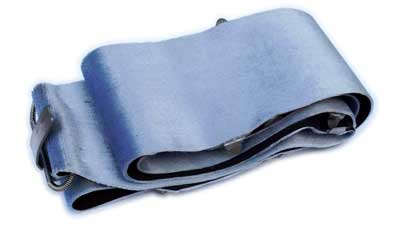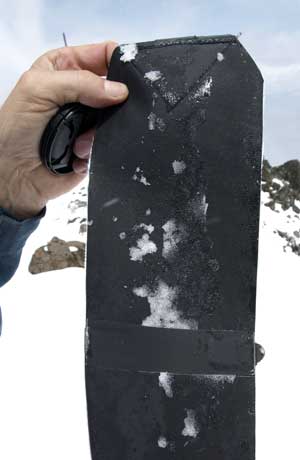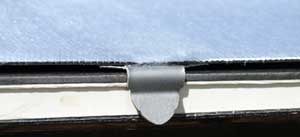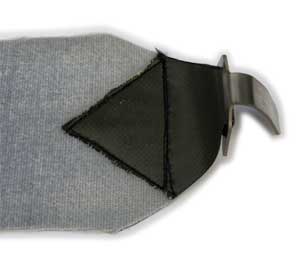When Kaj Gyr first told me of his idea for glueless climbing skins I was intrigued but skeptical. Glued skins have always had the potential for trouble, but with proper care and a bit of luck I’ve been satisfied with most pairs of skins I’ve used. Occasionally I’ll get a pair with a bogus batch of glue, but that’s not the norm.

However the potential for trouble doubles with fat skins. The more glue you have, the more you tempt fate.
Half the reason I still refuse to own a pair of skis wider than 90mm at the waist, and by extension, climbing skins wider than 90mm either, is because you can’t easily rip the hide when skins get wider than 85mm throughout their length. With a skinny, 80mm wide skin I can “rip the hide” in one fell swoop. Increase the width to only 90mm and I’m straining to separate the skin from ski every centimeter of its length. Make ‘em wider than 90mm and most folks are forced to take their skis off and use their body weight to get the skins off the skis.
The severity of how much force is necessary to rip wide hides was driven home when Kaj told me about a friend of his who fell over after straining to rip his skins from his skis. He pulled so hard he lost his balance, fell over, cracked the cornice he was standing on and was tumbled in an avalanche for 1500 feet.
Thankfully he was unhurt, but the lesson, besides not standing on a cornice, was that fat glued skins are annoying difficult to work with anymore and something needs to done about that. Split skins are one way to deal with excess adhesion, but the reality is if someone could come up with a glueless design that gave the same functionality without the potential trouble glue poses it’s doubtful I’d be the only one seriously interested.
Kaj started experimenting with alternatives to both glue and strap-on skins without glue and the result is his Clip-Skins design. A tip loop and tail hook provide longitudinal tension to hold the skin to the ski while six pairs of stainless steel clips hold the ski by the side walls to prevent the skin from slipping sideways. Instead of the now common stretchy tail hook, a simple steel tail hook cams over the ski tail with elasticity provided by the natural stretchiness of the skin material.
 Last Spring Kaj sent me an early version of Clip-skins. Assuming the attachment system worked, my biggest concern was the potential for snow to creep in between the p-tex of the ski and the skin backing material, creating an uneven surface with poor grip and worse glide. In half a dozen tours, four in powder conditions where I would expect this to be an issue, this condition was never realized. There was a small amount of snow that did sneak between the surface of the skin and ski, but it didn’t affect grip or glide and I didn’t notice it until after taking the skin off.
Last Spring Kaj sent me an early version of Clip-skins. Assuming the attachment system worked, my biggest concern was the potential for snow to creep in between the p-tex of the ski and the skin backing material, creating an uneven surface with poor grip and worse glide. In half a dozen tours, four in powder conditions where I would expect this to be an issue, this condition was never realized. There was a small amount of snow that did sneak between the surface of the skin and ski, but it didn’t affect grip or glide and I didn’t notice it until after taking the skin off.
The other concern was with the clips themselves. Would the clips prevent holding an edge while traversing hard or icy snow? On the first few tours out I made sure to include a few sections of traversing steep hard snow. The clips didn’t impede edging or grip, but I didn’t think the conditions were that challenging either. Next tour they were though. To test their limits I traversed onto a 38 degree slope of not merely hard snow, but the glazed, icy variety. If I weren’t testing the clip skins I would have switched to ski crampons for sure, or better yet, boot crampons with the skis on my back. Fortunately the clips never got in the way, providing solid edge hold even when directly contacting the ice. With traditional strap style skins that traverse would have been impossible.
 The other concern with the clips was how they are held to the ski backing material — with glue. I guess you could say that even clip-skins use glue, which begs the question: How good is that glue? How long does it last? I can’t answer the longevity question, but I can say that the glue that came with my beta Clip-skin kit was damn strong, so strong you best be careful how you handle it when attaching the clips or you’ll regret your carelessness. Until I’ve logged a year or so all I can say is the attachment of the clips, if not bombproof, appears sufficient which, theoretically, is good enough.
The other concern with the clips was how they are held to the ski backing material — with glue. I guess you could say that even clip-skins use glue, which begs the question: How good is that glue? How long does it last? I can’t answer the longevity question, but I can say that the glue that came with my beta Clip-skin kit was damn strong, so strong you best be careful how you handle it when attaching the clips or you’ll regret your carelessness. Until I’ve logged a year or so all I can say is the attachment of the clips, if not bombproof, appears sufficient which, theoretically, is good enough.
If properly handled, gluing the clips in place is simply a necessary part of the process of fitting. However, if there is an Achilles heel to this design, it is the process of preparing these skins for a single pair of skis. I won’t belabor the process here for two reasons. 1) I haven’t the patience to describe it, and 2) the recommended procedure is still in flux so any advice will probably be irrelevant by the time you decide to get a pair yourself. One bit of advice will probably remain.
Because the clips must hug the sidewalls, the skin material needs to trimmed to the exact shape of the ski. For those who are familiar with trimming your skins to the shape of your skis this all sounds normal and easy, except it isn’t. Trimming a skin to the shape of your ski with a glue base is easy. Trimming a skin to the shape of your ski without glue requires a lot more care, patience, and time.
By the time this design is available at the retail level I expect Kaj will have developed some sort of jig for bonding the clips to the backing material as well as some repeatable, reliable tricks for making the trimming easier. Even so, I expect that preparing Clip-skins will require a level of craftsmanship that not all shops will be comfortable providing.
Aside from the labor-intensive fitting process, how do the Clip-skins stack up?
Without glue, they are far easier to handle. You don’t need to worry about dropping them in the dirt, or storing them in a cool, dry place for the summer or accidentally leaving them on the dash or in the trunk of your car where the heat would certainly kill the glue. They are probably limited to fitting one pair of skis so you won’t be able to loan them to a friend in need. Without glue these skins should be lighter than comparable glue based skins.
The real benefit though comes when it’s time to take your skins off. Go ahead, leave your skis on, lift the tail up behind you so it’s just behind your shoulder, reach around with your hand and then pry the tail hook off the tail of your ski and then pull the skin away from your ski by merely flicking your thumb. The skin will effortlessly zipper away from the ski and you can laugh at your friends who are struggling to pull their skins off. While they’re carefully trying to adhere the skin saver strip to the glue of their overweight skins, you can be making first tracks.
 Was there anything I didn’t like about these skins? Aside from the prep time and one pair limitation, only one. The tail hook is held to the skin by a loop of hypalon that is sewn to the tail of the skin. This forms a small but noticeable bump of material that will be a magnet for snow to stick to, creating drag and a place for ice build-up. Hopefully this will be improved in the next or final version.
Was there anything I didn’t like about these skins? Aside from the prep time and one pair limitation, only one. The tail hook is held to the skin by a loop of hypalon that is sewn to the tail of the skin. This forms a small but noticeable bump of material that will be a magnet for snow to stick to, creating drag and a place for ice build-up. Hopefully this will be improved in the next or final version.
Considering the potential for this scenario to be reality, an hour or two preparing your Clip-skins to fit your skis seems a reasonable price to pay for lighter weight climbing skins without the hassles glue often provides.
***
Discussion of Clipskins @ teletips here
For those interested in obtaining a pair of Clip-Skins, Kaj Gyr will continue a Beta Test Program through December 2010. Patterned after the Hammerhead beta program pioneered by Russell Rainey ten years ago beta Clip-skins will be available for $120 with free shipping in North America. Kaj encourages you to give as much constructive criticism as you are willing to provide to help refine the final product. Once finalized you will receive an up to date new pair of skins for free.
Clipskins
250-505-4677
www.clipskins.com

3 comments
Great to get the feedback Craig.
A number of changes have been made since the early version I sent you. The method for trimmng and mounting clips has been simplified considerably, so the procedure is no longer something you have to go to night school to accomplish.
As for whether the clips stay bonded to the skin, I`ve augmented the glue with a thin sailcloth sleeve which requires vice grips and plenty of muscle to remove. I`ve also added an adjustable tip loop that will fit any width.
The beta testers have been very helpful, so we`re getting very close to having a finished product.
Thanks, Kaj
A blacked-out pass can only mean one thing, its time to have some fun in the ‘country.
With an upcoming Jakes tour on the horizon I needed to test out some gear out to make sure I was prepared for my upcoming adventure. A quick hike up a small local hill (800 feet of vertical) seemed like just the spot to do this and Craig generously loaned me one clip-skin and one regular skin for a little comparison testing.
The clip-skin seemed like an excellent idea to me… I honestly wondered why no one had thought of it before. There is no glue to complicate things and it is super easy to get on and off the ski. I honestly was excited to give them a go.
During my short hike however, I came to realize that the biggest pro of the clip-skin is also its biggest con. Easy on and off is great but such easy removal also allows for the skin to fall off at inopportune moments. When the skin gets wet and stretches, the tensioning system which primarily holds the skin to the ski is not up to the task. My short hike resulted in the clip-skin falling off four times.
Although this falling-off action was annoying, it only took a moment to get them back on and be on my way. I feel the problem could be easily remedied by a better tensioning system like Black Diamond’s STS.
Overall the clip skin is a great idea. In its beta form it needs a little work but when in comes to market I am sure it will be a viable alternative over traditional sticky skins.
Indeed about 50% of the beta version, and a portion of the first production run suffered from skin material that stretched too much, particularly when wet. It took me awhile to narrow down the problem, and it’s taken me even more time to figure out how to address it, as only portions of the large rolls of material I get were too stretchy. I’ve begun testing each and every length of material, sorting out the good from the bad, and just to ensure the skin doesn’t stretch over time I’ve started laminating a fiber-reinforced Mylar film to the back of the skin. This has totally solved the problem. I can now turn my attention to the real prodution issues – churning out enough skins (of consistent quality)for all the orders I’ve been getting.
Adding an elastic tail cam like the STS system (which is my preferred system for glued skins)doesn’t work, as it’s very important for the skin, especially towards the rear, to be as inelastic as possible, as traction forces exert a strong pull on the tail cam with Clipskins — without glue to hold the skin it slides if not held in place by the tail cam — unlike with glued skins.
As always, feedback is appreciated.
Kaj Gyr